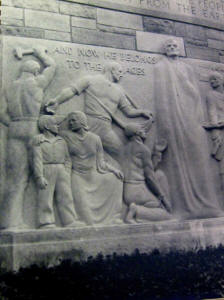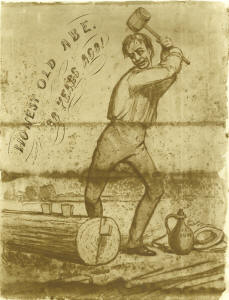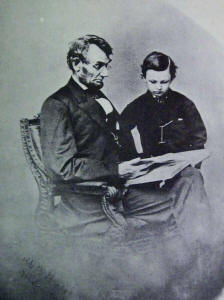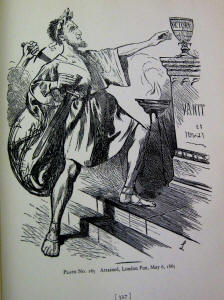|

|
Table of Contents
Home
Slavery
& Race
The South
Visual
Representations
Memorials
& Appropriations
Slavery
& Race
Sarah
Henderson
Joe Levell
Dan Haller
Nick
Schradle
The South
Dean DeChiaro
Steve Schaffer
Rick Ramirez
Visual
Representations
Alana Lemon
Jon Ingram
Peter Fúster
Aaron Stanton
Memorials
& Appropriation
Charles
Bennett
Molly Storer
Emma
Thorne-Christy
Other Online
Exhibits
|
Visual
Representations
Introduction
From a young Kentucky
rail-splitter to the savior of the
Union, visual portrayal of Abraham
Lincoln remains a national
obsession for most Americans.
Having lived in the era that
witnessed the birth of the camera,
Lincoln remains one of the most
formally photographed U.S.
presidents. [more]
These
numerous images from his life
have been the basis for
increasingly diverse artistic
renderings of this beloved
figure.
The range of these
representations, from
romanticized paintings of his
Gettysburg speech to George Grey
Barnard's controversial Lincoln
sculpture in Cincinnati,
exemplifies the diversity of
Lincolnian mythology. Visual
representations are one way in
which various individuals and
groups have appropriated the
life and legacy of the president
in order to lend validation to
their respective causes. Thus an
analysis of differing depictions
of Lincoln allows the viewer to
identify what aspect of Lincoln
the artist has chosen to
emphasize, valorize, or even
disparage.
|
|
 Daniels,
E. H. "Apotheosis".
The Lincoln
sculptures. Daniels,
E. H. "Apotheosis".
The Lincoln
sculptures.
Lincoln City,
Indiana: Nancy Hanks
Lincoln Memorial. 1943.

-
Alana Lemon
This image is the final
and central panel of the
Nancy Hanks Lincoln
Memorial in Lincoln City,
Indiana. Completed in
1943, it is one of many
images of Lincoln sculpted
by E.H. Daniels.
While the
other four images depict
events in the life of the
president, this final
panel is representative of
the memorialization of
Lincoln after his
assassination. In a
forward to the works of
Daniels, Z.C. Sanderson
points to the memorial's
emphasis on the pioneer
roots of the president,
"terminating with an
apotheosis, a benediction
to a man who in life
guided the destiny of a
nation through the terrors
of war and freed a people,
and who in death continues
to grow in the hearts of
all". Indeed the Lincoln
in this sculpture has
achieved the status of a
god. He towers over the
figures surrounding him,
body masked in a flowing
cloak. To one side are
five figures meant to
represent humanity, the
world of Lincoln's life.
To his other side stand
Cleo, the Muse of History,
and Columbia, the female
personification of the
America, indicating his
ascension beyond the
mortal realm to that of
myth and legend. They
extend to Lincoln a laurel
branch, a traditional
symbol of Victory. In the
background, a small log
cabin is dwarfed by the
Greek temple of the
Washington D.C. Lincoln
Memorial, further
emphasizing his rise from
western farmer to
historical hero.
Above Lincoln's head are
engraved the poignant
words "And now he belongs
to the ages". Running
along the top of the panel
is the final sentence from
the Gettysburg Address:
"that this nation, under
God, shall have a new
birth of freedom; and that
government of the people,
by the people, for the
people, shall not perish
from the earth." As his
words have been
immortalized in stone time
and again, Lincoln has
become an immortal and
transcendent figure.
Click
on Image
for Larger View
Return to
Top
|
|

“Honest
Old Abe . 30 Years
Ago” Image
Occidental College Special
Collections Lincolniana
Box R2/43 (60)
- Jon
Ingram
Visual
representations of Abraham
Lincoln have not always been
dignified or beneficial
renditions of America’s most
adored president. This
particular rendition of
Lincoln is a throwback to
his early life, a time that
built his reputation as the
“common man” and rail
splitter, a quaint image
that was used to win the
hearts of the American
people in the 1800s. In this
probable campaign piece, the
opposing party (likely the
Democrats) used this
depiction of his early years
as a mudslinging tactic.
This poster is not the
original. Rather, it appears
to be a copy of an older
poster that likely dated
from the mid-1800s.
The viewer can see in this
characterization a very
different portrait of
“Honest Old Abe. 30 Years
Ago”, as the poster’s title
refers to him. While
dominating the foreground of
the poster, Lincoln is shown
to be an extraordinarily
ugly figure which plays on
his natural ungainly figure
and uncommon height. He is
shown to seemingly be
working hard. However,
judging by the lack of
success Lincoln is having in
splitting the log, the
artist is attempting to show
him as incapable or
unsuccessful at manual
labor. This is further
exemplified by the jug of
rum that sits close at hand
in the bottom right corner,
which is an interesting
addition because of the
legendary tales of Lincoln’s
soberness.
This poster likely emerged
from the 1860 presidential
campaign. This date can be
inferred due to several
additions in the poster and
elimination of the
possibilities. The “30 years
ago” title gives an
approximate time period due
to Lincoln’s birth in 1809.
Lincoln would have had to
have been older than fifteen
in order to be splitting
rails. Furthermore, the
original poster would have
been used in the 1860
campaign because it was at
that point that Lincoln was
the unknown Republican
running as a common man.
These demeaning allegations
attempt to show him as
incapable of office due to
his laborer past and
questions against his state
of mind, qualifications, and
morals. This seems to be a
twist of political ideals.
At this time, the Democratic
Party towed the line of
being representational of
the “common man”, as opposed
to the rich Whigs and
Republicans. Through this
buffoonish Lincoln they
connote all the things wrong
with what they were
attempting to represent,
ideals that Lincoln now
represented within the
opposing Republican Party.
No longer could the
Democrats attack their
opponents for being New
England “blue bloods”,
rather they were reduced the
hypocrisy of attacking their
own ideals.
In Douglas L. Wilson’s Honor’s
Voice we can see how
these types of
representations have played
out in the memory of
Lincoln. [1] Lincoln’s early
years are made up of much
speculation, hearsay, and
tall tales that contain both
truth and fiction. Wilson
reveals this in his attempts
to trace the different
accounts of Lincoln’s life.
The key point that emerges
from this is that Wilson is
able to show the large
amount of ambiguity about
this time period and
Lincoln’s progression to the
presidency. This ambiguity
is highlighted and played on
by the poster copy, as it
relies on a very vague and
unclear time period in
Lincoln’s life, a period
which Lincoln himself never
elaborated much on. The
poster’s ultimate purpose is
to make insinuations about
aspects of Lincoln’s
character and sow doubt in
voter’s minds. Despite these
insinuations, the poster can
help modern historians
analyze the opinions of the
time and how people viewed
Lincoln as a presidential
candidate.
[1] Wilson,
Douglas L.
Honor's
Voice: The Transformation
of Abraham Lincoln. Vintage,
1999.
Click on
Image
for Larger View
Return to
Top
|
|
 Hamilton,
Charles and Ostendorf,
Lloyd. Lincoln in
Photographs: An Album of
Every Known Pose Hamilton,
Charles and Ostendorf,
Lloyd. Lincoln in
Photographs: An Album of
Every Known Pose
Norman:
University of Oklahoma
Press, 1963. 182-183.
-
Peter Fúster

This portrait
of Lincoln reading a book
with his youngest son,
Tad, is one of the most
famous and beloved
portraits of the
President. Compared
to the theme of the
immortal, strong Great
Emancipator which tends to
define the portraits taken
of him during the Civil
War, Lincoln appears like
a gentle, approachable
father figure in this
picture, wearing his
reading glasses as Tad
stands at his side looking
on. The moving image
of the legendary president
sharing a touching moment
with his son makes Lincoln
appear human, which adds
another aspect to the
legend of “Father
Abraham”. This
portrait became so famous,
that it inspired numerous
portraits and sculptures
based on the same father
and son theme, such as the
examples displayed here.
In addition to
being portrayed as a
father figure, Lincoln is
also portrayed as an
empathetic family man.
The fact that he is
finding time to be with
his son despite having had
two sons die already and
having to deal with the
daily carnage of the Civil
War makes this moment even
more tender and emotional.
We feel for Lincoln,
since this is probably of
the few joys he has left
in his life since becoming
President. In
addition, the sight of a
father reading with his
son is a pleasant contrast
to the reality of young
men dying on the
battlefield by the
thousands. In the
end, this photo is popular
and poignant because it
shows a different side of
Lincoln, a side that does
not deal with slavery or
the Civil War. It is
a sign of light and hope
in the darkness of a
divided union.
Click on
Image
for Larger View
Return to
Top
|
|
 Wilson,
Rufus Rockwell.
“Attained” Lincoln
in Caricature. Wilson,
Rufus Rockwell.
“Attained” Lincoln
in Caricature.
New
York: Horizon Press, 1953.
Plate #163. from "London
Fun," May 6, 1865
-
Aaron Stanton

This cartoon
captioned “Attained” from
“London Fun” in May of
1865 is a great
representation of Lincoln
as martyr. The cartoon
portrays the triumphant
Lincoln reaching for the
cup of victory, but just
before he can fully grasp
it, he is stabbed from
behind. This portrayal of
Lincoln’s death at the
moment of his greatest
triumph invokes the
feeling that Lincoln was
cut down too early, at the
hour when the country as a
whole, needed him most.
While this cartoon may
bring elements of satire
and irony, being it was
published in a British
magazine, it also portrays
an image of what Drew
Gilpin Faust
calls the “good death.”
[1] That is, dying
honorably in the pursuit
of a greater purpose, in
this case the unifying of
the Union through the
Civil War. However,
another aspect of the good
death is that the one
dying should die bravely
in the company of family
and loved ones. Lincoln in
this caricature, while
portrayed triumphant, is
shown being killed in a
very dishonorable way that
some may argue blemishes
Lincoln’s honorable or
“good death” for the
posterity.
However, I would argue
that even though Lincoln’s
portrayal in this cartoon
may go against 19th
century ideals about the
good death, the four years
of fighting had already
begun to take their toll
on notions about dying.
Because of this, and the
fact that Lincoln’s death
was an assassination, any
qualms about the memory of
the murder and Lincoln
himself are rectified.
Also, the fact that
Lincoln was killed at the
height of his popularity
and success helps to
enshrine the President
forever as a martyr and
hero. This portrayal may
be one of many ways in
which Abraham Lincoln is
remembered, but to many it
is one of the most
powerful.
[1]
Faust, Drew
Gilpin. This Republic of
Suffering: Death and the
American Civil War. New
York: Knopf, 2008.
Click on
Image
for Larger View
Return to
Top
|
|
| |
About
this Project / Acknowledgements
Occidental
College's "Lincoln Legacies"
Research Seminar was developed by
Dr. Jeremiah B.C. Axelrod, Adjunct
Assistant Professor of History.
The library project
is developed in collaboration with
the Special Collections
Department:
Dale Ann Stieber, Special
Collections Librarian with student
staff
Alana Lemon and Brittany Todd.
Main graphic
images:
|
|
Page last edited on 03/12/2013.
Occidental
College Library Special
Collections & College Archives
© 2010 Occidental College
|
|
|
|
|
|